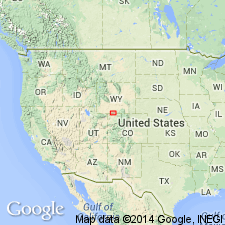
- Usage in publication:
-
- Adobe Town Member*
- Modifications:
-
- Original reference
- Dominant lithology:
-
- Mudstone
- Sandstone
- Tuff
- AAPG geologic province:
-
- Green River basin
Summary:
Pg. 4 (fig. 1), 14-17, 26-36, pls. Adobe Town Member of Washakie Formation. Chiefly green, gray, and red, tuffaceous mudstone alternating with gray, fine- to coarse-grained, tuffaceous and arkosic sandstone. Thickness up to 2,300 feet. Includes Rose-red and Robin's-egg-blue marker beds. Unconformably overlies Kinney Rim Member of Washakie Formation in west and Laney Member of Green River Formation in east. Underlies Browns Park Formation. Fossils (vertebrates). Age is middle and late Eocene; Bridgerian C-D and Uintan B Provincial Ages of Wood and others (1941).
Type section: [middle part], beds 629-675, on slopes of major north-trending dry wash, [along Skull Creek], in NW/4 sec. 29 and W/2 sec. 20, T. 13 N., R. 97 W., [Upper Powder Spring 7.5-min quadrangle], Sweetwater Co., southern WY.
Principal reference sections: (1) upper part, beds 676-708, at Adobe Town, in NW/4 sec. 30, and SE/4 sec. 31, T. 15 N., R. 97 W., [in northwest corner of Monument Valley 7.5-min quadrangle], Sweetwater Co., southern WY; and (2) lower part, beds 569-628, in NW/4 sec. 29, and SW/4 sec. 20, T. 13 N., R. 98 W., [Cow Creek Reservoir SW 7.5-min quadrangle], Sweetwater Co., southern WY.
Named from Adobe Town, Sweetwater Co., southern WY.
Source: Publication; US geologic names lexicon (USGS Bull. 1520, p. 6).
For more information, please contact Nancy Stamm, Geologic Names Committee Secretary.
Asterisk (*) indicates published by U.S. Geological Survey authors.
"No current usage" (†) implies that a name has been abandoned or has fallen into disuse. Former usage and, if known, replacement name given in parentheses ( ).
Slash (/) indicates name conflicts with nomenclatural guidelines (CSN, 1933; ACSN, 1961, 1970; NACSN, 1983, 2005, 2021). May be explained within brackets ([ ]).

